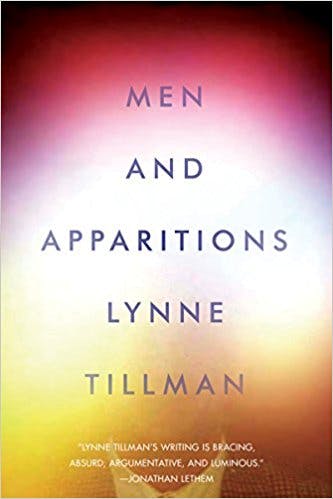“The miracle of photography, of its so-called objective image,” wrote Jean Baudrillard, “is that it reveals a radically non-objective world.” A photograph creates the illusion of a stable reality. But what it truly captures is the most passing revelation—a kind of social “apparition” from which we gather clues.

This miracle lies at the heart of Men and Apparitions, Lynne Tillman’s idiosyncratic new novel. Ezekiel Hooper Stark, the cultural anthropologist at its center, studies family photos, and he sees keenly how images construct the mysteries of identity. “A family’s secrets appear as absences and exclusions, erasures and deletions,” Zeke says. “The not-there, un-pictured life—think about it, an un-pictured life—or invisible story, hangs around the edges of albums, obscene, out of sight, off screen, you name it.” In other words, there’s more reality there than we see. Zeke has blind spots, too. Reeling from romantic upheaval, he embarks on a project to study the image of the New Man, raised in the 1990s “under the sign of feminism.” It’s an effort to reveal the apparitions of his subjects’ masculinities—and his own.
The photos we capture—and launch from our devices onto Instagram, YouTube, Tinder—extrude our desires into the ether, and Tillman has attuned her antennae to their strange frequencies. For her, they raise questions of heredity. What images of family and self have we inherited? How do we assemble our identities—of families, genders, and physical bodies—and the “un-pictured” life at their margins? And can we change the way we see them? In a novel that overflows with obsessive, encyclopedic energy, her characters luxuriate in self-conscious play, double meaning, and provocative inquiry. The result is a work that enlarges our understanding of what the novel can be—and the sense of self we take for granted.
“All ‘portraits’ are also self-portraits,” Zeke announces early on. Charming and chatty, Zeke is a familiar Gen-X male, whose childhood passion for family photos has yielded a cozy middle-class career as an ethnographer. His image is one of ironic self-awareness and near-compulsive intellectualism. Ideas dominate plot in Men and Apparitions—it’s full of long, discursive passages about family image, aesthetic theory, and photographic history (not unlike those Tillman has published elsewhere in essay form). But Zeke’s obsessions also occlude twin family traumas. His wife has left with his closest friend. His little sister, Little Sister, has ended her life. Baudrillard warns of an “absence of reality” in the pictured image. But what are we to make of such absence in a life?
Zeke’s self-portrait develops as he waxes scholarly about our pictures, ourselves. The ones he studies are mostly amateur, bought or found, and reproductions are scattered throughout the novel with his notes, a kind of antic analytic poetry. A picnic “signifies an idyllic image; the actual event is mostly hellish.” A girl among flowers is “embraced by her garden,” a true idyll. Tillman writes pictures the way Jeanette Winterson writes the body: with great and counterintuitive attention to detail, theorizing and revising as she goes. She leaves space for Zeke to trawl a list of high and low subjects, from Kruger to Kardashian, Foucault to Federer, reflecting the hyperflow of information to which we’ve become accustomed. “Does anything live up to its image?” Zeke asks.
There are family images too. A cross-dressing uncle, Zeke’s namesake, makes an appearance in drag to suggest a legacy of alternative, though carefully self-regulated, masculinities. Photographic blurs, we learn, once “documented ghosts,” and Zeke effects a spiritual communion of his own with the image of his long-dead cousin, Clover Hooper Adams, a nineteenth-century socialite.
Zeke’s nuclear family presents him with greater complications. Father, an alcoholic, “claimed he was a male feminist, but he was a condescending asshole contented in his bona fides.” Mother, a feminist in a loveless marriage, drums into him that “a marriage contract turned women into their husband’s property, like sheep.” Bro Hart appears as little more than adenoids and a phallus. Little Sister suffers from “selective mutism,” a symbol of the voicelessness that women continue to suffer in our post-feminist age. It’s the middle-class family of the American imaginary.
Like so many men of his generation, Zeke defines his adult image of heterosexual love in opposition to this scene. From his wife, Maggie, he seeks companionship without conflict. They are, in his view, “lovers as border guards not allowing others entry.” These borders, of course, are impossibly confining. When his friend reveals an affair with Maggie, apparitions come streaming out of the haunted attic of Zeke’s New Man edifice of irony and intellect. We find him saying decidedly Old Man things like “I would’ve killed him if he’d touched me, I swear I would have” and “Hurt her, fuck her, get her back, murder her.” He watches a ton of porn and hires a prostitute. Finally, he wanders Europe in a dissociative “fugue state,” during which he assumes the name of Henry Adams, his ancestor Clover’s repressive husband. What we’re supposed to understand is that he loses his faith in appearance: “I never imagined she wore a mask,” he says of Maggie, “and I don’t know why I didn’t.” His image as a New Man has failed him.
It’s staggering to watch Tillman so precisely dissect Zeke’s Gen-X masculinity and its contradictions. More than once I put the book down to grimace in rueful self-recognition. His reflexive tics of speech—“haha,” “kidding,” “totally,” “cool”—serve to qualify his bold assertions, and his tumbling comma splices approximate the style of the blog confessional. Contained within Zeke’s language is his vision of manhood, one deeply ambiguous and ambivalent, shaped as it is by shifting gender ideals. He could talk to you about it all day, but it’s out of his control.
One thing Men and Apparitions makes clear is that the feminism of the New Man is precarious. These days, we don’t need to look very far to see that the New Man’s gentler, more reflective feminist image can conceal the apparitions of a rougher, more thoughtless masculinity. It’s what sociologist Avery Gordon describes as a “haunting.” The concept, writes Gordon, helps explain how social phenomena that appear to be absent can remain “a seething presence, acting on and often meddling with taken-for-granted realities.” There are ghosts at the edges of our picture of progress, and many of them are materializing into the frame even as I write.
In Zeke’s case, all the voracious discursive stuff—all the “thick description” his ethnographer-hero Clifford Geertz espoused—avails him nothing. And no event underscores that like Little Sister’s suicide, the ultimate act of self-silencing. After all, from behind our cameras or desks, or even from “in the field,” what can we actually capture and keep? Our families, our companions, our hellish picnics in our cozy lives? These images remain elusive and illusory. Plus the search is devouring him.
Men and Apparitions’ final hundred pages takes the clunky form of Zeke’s ethnography, Men In Quotes. It’s a forensic look inside the minds of New Men. It’s also an attempt to put the very notion of “men” in quotes—to once again question what we think of as manhood. In truth, it’s less of a study and more of a mirror. His “sample” is small and deliberately like him: white, straight men of Gen-X. But it helps him to understand the slippage in his intellectual defense: “We who are jaded, we’re the worst, because we deny a need in ourselves for the illusions we work hard to shatter. Super-vulnerable.” One way of looking at this is that Zeke goes from focusing on his family to focusing on the only thing that he might change: himself. From this place of vulnerability, old and useless ghosts emerge to be seen and scrapped, and—even for a devout atheist like Zeke—it approximates the spiritual.
The pseudo-study feels like anticlimax. It’s not so formally different from the rest of the book, which I take to the be the point: The character has given up the ruse of objectivity. But I’m not sure the novel needs it, and it appears as its own postmodernist formal convention. Still, it’s illuminating, if unsurprising, to hear Zeke’s cohort say things like “perhaps the convincingly sensitive routine was just a Trojan horse to conceal a caveman” and “My father’s generation took women’s sexual freedom as a given” and “That is the cost to women who ignore their sisters’ gains—some men, like me, will think less of them.” Men have grown in consciousness, but also in confusion. Could that confusion yield a new New Man?
If Men and Apparitions is an image, it’s a Polaroid—maybe a haunted one—that someone hands you as it’s still developing. Tillman insists that there are formal and social conventions yet to be upended and rethought. Even if she doesn’t achieve it herself, the magic is that you can see them materializing in your hand. Hers is a studied amateurishness, a considered immediacy. These layers are part of her brilliance in conveying the self-in-progress.
Baudrillard, for his part, figures only briefly in the novel, as one of Zeke’s many theoretician-fathers, and the passage fittingly concerns the uncanniness of the Polaroid. Its instantaneous image, writes Baudrillard, is “a sort of ecstatic membrane that has come away from the object.” In the age of the smartphone, this is truer than when he wrote it, our images more reproducible and disposable—and especially more uncanny. The big question for Baudrillard was always whether this instantaneity gets us closer to the “real world” or, because it’s artificial, keeps the world at a distance. We men, who believe we are changed, are almost (but not quite) the same as our parents. Progress, whatever that means, is slow. It takes a long time—generations, maybe—to peel away the membrane and see that the self we’ve created is just an image.
Somewhere in the middle of his marital grief, Zeke’s mother tries to comfort him with that old commonplace: When he’s himself again, he won’t think this way. “I don’t buy that there’s a self waiting for me to return to,” Zeke thinks. In Tillman as in life, rejecting that brittle old self-image is about the best we can hope do—and it’s good enough.
